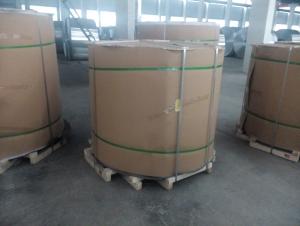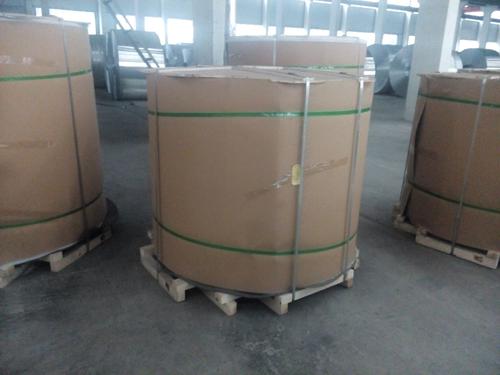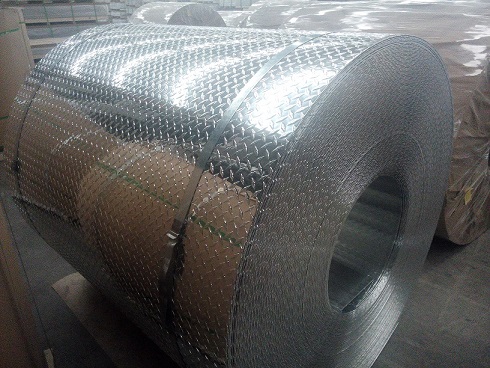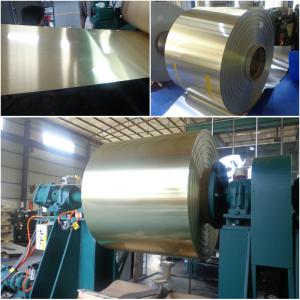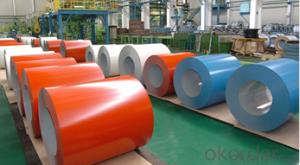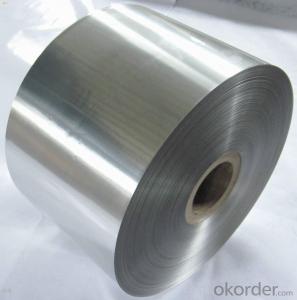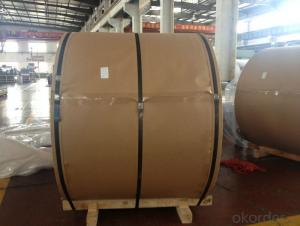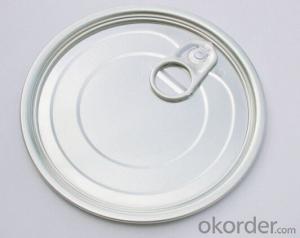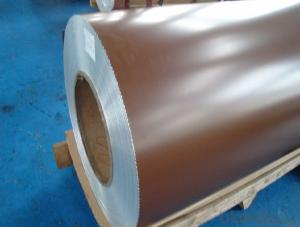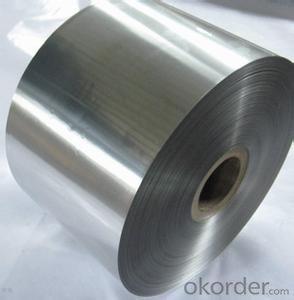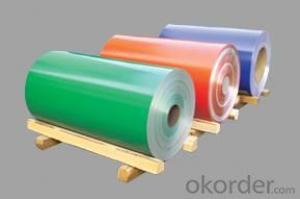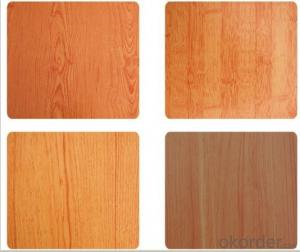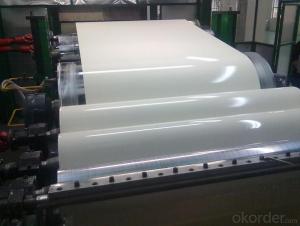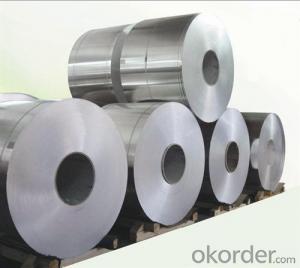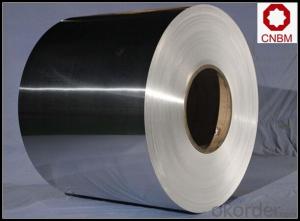Pvc Coated Pattern Aluminum Coil Stock
- Loading Port:
- China Main Port
- Payment Terms:
- TT OR LC
- Min Order Qty:
- -
- Supply Capability:
- -
OKorder Service Pledge
OKorder Financial Service
You Might Also Like
Pointer type pattern roll.Aluminum hard alloy checkered plate: 3003 as the main raw materials, strength slightly higher than ordinary aluminumalloy pattern plate, has a certain anti rust performance.Mainly used for non slip floor and building decoration etc.I produced the thickness range from 1.143mm to 3.175mm, width range from 900mm to 1500mm. The pattern of reinforced high according to the thickness of the aluminum plate was increased from 0.6mm to 1.2mm .3003 alloy. Smooth and bright surface, the pattern for a bar, also known as pointer type. Mainly for export. For export packagingvertical packing seaworthy,Plate thickness 1.143mm, corresponding to the pattern height 0.6mm, plate thickness 1.422mm, corresponding to the pattern height 0.65mm, plate thickness of 1.473 corresponding pattern, height 0.7mm; aluminum thickness 1.60mm,corresponding to the pattern height 0.80mm, plate thickness of 2.0mm, the corresponding pattern height 0.90mm;aluminum thickness 2.54mm, the corresponding pattern height 1.0mm; aluminum thickness 3.0mm
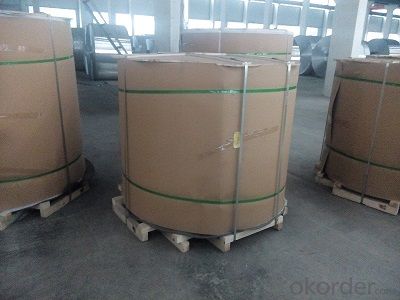
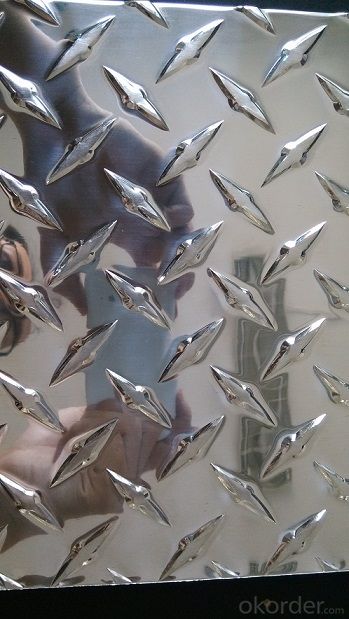
- Q: Can aluminum coils be used in aerospace heat exchangers?
- Aerospace heat exchangers can indeed utilize aluminum coils. In the aerospace industry, aluminum is widely employed due to its lightweight nature and exceptional thermal conductivity. Heat exchangers play a critical role in aerospace systems by transferring heat between different mediums. Aluminum coils effectively conduct heat, making them suitable for aerospace heat exchangers. Moreover, aluminum's resistance to corrosion is essential in the challenging environments encountered in aerospace applications. Additionally, its low density contributes to fuel efficiency by reducing the overall weight of aircraft. Hence, aerospace heat exchangers prefer aluminum coils owing to their outstanding thermal conductivity, lightweight properties, and corrosion resistance.
- Q: What are the different coil slitting methods used for aluminum coils?
- There are several coil slitting methods used for aluminum coils, each with its own advantages and applications. Here are some of the common methods: 1. Rotary Shear Slitting: This method involves using rotating circular knives to cut the aluminum coil into narrower strips. It offers high precision and speed, making it suitable for producing large volumes of narrow strips with consistent widths. 2. Loop Slitting: In this method, the aluminum coil is passed through a loop, where it is cut using rotating knives. Loop slitting allows for high-speed processing while minimizing the risk of damage to the coil's surface. It is commonly used for thinner gauge aluminum coils. 3. Double Knife Slitting: As the name suggests, this method involves using two blades to make parallel cuts along the length of the aluminum coil. Double knife slitting is suitable for thicker gauge coils and can produce wider strips compared to other methods. 4. Scissors Slitting: This method utilizes a pair of scissors-like blades to cut the aluminum coil into strips. Scissors slitting is versatile and can handle a wide range of coil thicknesses. It is often used for smaller scale operations or when precise width tolerances are not critical. 5. Crush Slitting: In crush slitting, the aluminum coil is pressed against a hardened roller or blade, causing it to deform and rupture along the desired cutting line. This method is ideal for delicate materials or when minimal burr formation is desired. Each slitting method has its own set of advantages and limitations, and the choice depends on factors such as coil thickness, desired strip width, production volume, and surface quality requirements. It is crucial to select the appropriate method to ensure efficient and accurate slitting of aluminum coils.
- Q: Is it possible to use aluminum coils for storage purposes?
- <p>Yes, aluminum coils can be used for storage, particularly for certain applications. They are often used in HVAC systems and electrical wiring due to their conductivity and flexibility. For general storage, aluminum coils may be suitable for winding and storing cables, wires, or similar materials. However, for storing items that require a specific environment or have weight concerns, it's important to consider the coil's strength and whether it can provide the necessary support and protection. Always ensure that the storage method complies with safety standards and the material's properties.</p>
- Q: How are aluminum coils tested for surface hardness?
- Aluminum coils are tested for surface hardness through a variety of methods to ensure their quality and suitability for various applications. One common method used is the Rockwell hardness test. In the Rockwell hardness test, a diamond or hardened steel ball is pressed into the surface of the aluminum coil using a specified amount of force. The depth of the indentation made by the ball is measured, and a hardness value is determined based on the difference in depth before and after applying the force. This value is then compared to a hardness scale to determine the surface hardness of the aluminum coil. Another method used is the Brinell hardness test. In this test, a hardened steel ball is pressed into the surface of the aluminum coil using a specified force. The diameter of the resulting indentation is measured, and a hardness value is calculated based on the applied force and the size of the indentation. This value is then compared to a hardness scale to determine the surface hardness of the aluminum coil. Both the Rockwell and Brinell hardness tests are non-destructive and provide accurate measures of the surface hardness of aluminum coils. These tests help manufacturers and customers ensure that the coils meet the required hardness specifications for their intended applications, such as in the automotive or construction industries. By testing for surface hardness, potential issues like brittleness or inadequate strength can be identified and addressed before the aluminum coils are used in the production process.
- Q: Can aluminum coils be used in the manufacturing of electronic devices?
- Yes, aluminum coils can be used in the manufacturing of electronic devices. Aluminum has excellent electrical conductivity and thermal properties, making it suitable for various applications in electronics, such as in transformers, inductors, and heat sinks. Its lightweight nature and corrosion resistance also make it a popular choice for electronic components.
- Q: How are aluminum coils formed into different shapes and profiles?
- Metal forming is the process by which aluminum coils are transformed into various shapes and profiles. This involves applying force to the coil to alter its shape and contour. There are multiple techniques employed for shaping aluminum coils, including rolling, bending, extrusion, and stamping. The most commonly used method for shaping aluminum coils is rolling. This entails passing the coil through a series of rollers that gradually change its shape by applying pressure. The rolling process can be carried out either hot or cold, depending on the desired outcome. Hot rolling is typically used for thicker coils, while cold rolling is suitable for thinner ones. Bending is another technique employed to shape aluminum coils, particularly when creating curved or angled profiles. This can be done manually or with the assistance of specialized bending machines. By exerting force, the coil is bent to the desired shape, creating curves or angles as required. Bending is widely utilized in applications such as HVAC systems, automotive components, and construction. Extrusion is a process in which the aluminum coil is forced through a die to achieve a specific cross-sectional shape. The coil is heated and pushed through the die, which determines the final shape of the extrusion. This method is frequently employed to create intricate profiles with consistent dimensions, such as window frames, door frames, and structural components. Stamping is a technique utilized to produce precise shapes and patterns on the surface of aluminum coils. It involves pressing the coil against a die with the desired design, causing the metal to deform and adopt the shape of the die. Stamping is commonly employed for decorative purposes, such as creating patterns, logos, or text on aluminum sheets. In conclusion, various metal forming methods, namely rolling, bending, extrusion, and stamping, enable aluminum coils to be transformed into diverse shapes and profiles. These processes facilitate the customization and versatility of aluminum in numerous industries and applications.
- Q: What are the rules and regulations concerning the disposal of old aluminum coils?
- <p>Yes, there are regulations on the disposal of old aluminum coils. These regulations vary by country and region, but generally, they aim to prevent environmental pollution and promote recycling. In the United States, for example, the Environmental Protection Agency (EPA) sets guidelines for recycling and disposing of scrap metal, including aluminum. Businesses and individuals are often required to recycle aluminum coils rather than sending them to landfills. Proper disposal may involve sorting, cleaning, and sending the coils to recycling facilities that can process and reuse the material. Violations of these regulations can result in fines and penalties. It's important to check local and national regulations for specific requirements.</p>
- Q: Can aluminum coils be formed into different shapes?
- Aluminum coils possess the capability to assume diverse configurations. Such metal, known for its high malleability, exhibits an ability to undergo bending, shaping, and forming without fracturing. This particular attribute deems it an optimal material for myriad applications necessitating flexibility and adaptability. Aluminum coils, employing a myriad of techniques like bending, rolling, stamping, extrusion, or even specialized machinery like a coil forming machine, can be fashioned into an array of shapes. These shapes encompass sheets, plates, tubes, wires, or intricate three-dimensional structures. The capacity to mold aluminum coils into assorted forms renders it an exceptional choice for sectors such as construction, automotive, aerospace, and manufacturing, where customized parts and components are frequently required.
- Q: How do aluminum coils contribute to noise reduction in buildings?
- Aluminum coils can contribute to noise reduction in buildings through their unique properties and installation techniques. Firstly, aluminum is a highly efficient sound insulator due to its density and ability to absorb and dampen sound waves. When used as coil insulation, aluminum can effectively block and reduce airborne noise transmission, minimizing the impact of external sounds on the building's interior. In addition to the inherent sound insulation properties of aluminum, the installation of aluminum coils in buildings can further enhance noise reduction. The coils can be strategically placed in areas where noise transmission is likely to occur, such as HVAC systems and ductwork. By tightly sealing these areas with aluminum coils, any potential gaps or openings that could allow sound to travel are eliminated. Moreover, aluminum coils can also act as a barrier to vibration and resonance noises. They can be installed around mechanical equipment or structural elements prone to vibration, effectively dampening these vibrations and preventing them from propagating throughout the building. This is particularly essential in reducing low-frequency noises, which are typically more challenging to control and can significantly impact the comfort and productivity of occupants. Furthermore, aluminum coils offer durability and longevity, ensuring their effectiveness in noise reduction over an extended period. They are resistant to corrosion, moisture, and other environmental factors, maintaining their sound-insulating properties and preventing sound leakage. Overall, by combining the sound insulation properties of aluminum with strategic installation techniques, such as sealing gaps and dampening vibrations, aluminum coils play a crucial role in reducing noise transmission in buildings. Their ability to absorb, block, and dampen sound waves makes them an effective solution for creating quieter and more comfortable indoor environments.
- Q: Are aluminum coils prone to corrosion?
- Yes, aluminum coils are prone to corrosion. Aluminum is a reactive metal that tends to oxidize when exposed to oxygen and moisture, leading to the formation of a layer of corrosion on the surface of the coil. However, this can be mitigated by applying protective coatings or using alloys that are more resistant to corrosion.
Send your message to us
Pvc Coated Pattern Aluminum Coil Stock
- Loading Port:
- China Main Port
- Payment Terms:
- TT OR LC
- Min Order Qty:
- -
- Supply Capability:
- -
OKorder Service Pledge
OKorder Financial Service
Similar products
Hot products
Hot Searches
Related keywords
